South Carolina is a state steeped in U.S. history as well as a great place to take a beach vacation. Also, this state is a good area to find a variety of interesting and unique animals. In this article, we’re going to identify and explore seven of the largest animals in South Carolina. You’ll learn how big they get as well as where to find them in this lovely Southern state.
What Are The 7 Largest Animals in South Carolina?
This list would be rather boring if we focused on the biggest animals that walk the land. That’s why we’re going to take a wider view of the largest animals in South Carolina.
We’re going to approach this list by looking at several different groups such as fish, mammals, amphibians, and more. After we’ve finished this list, you’ll know all sorts of big creatures in the state!
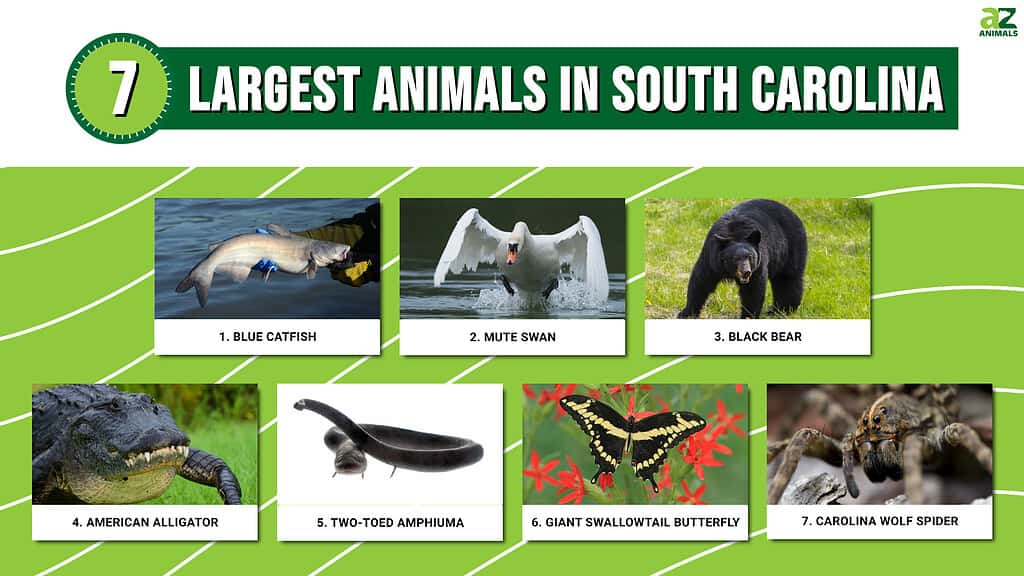
1. Blue Catfish
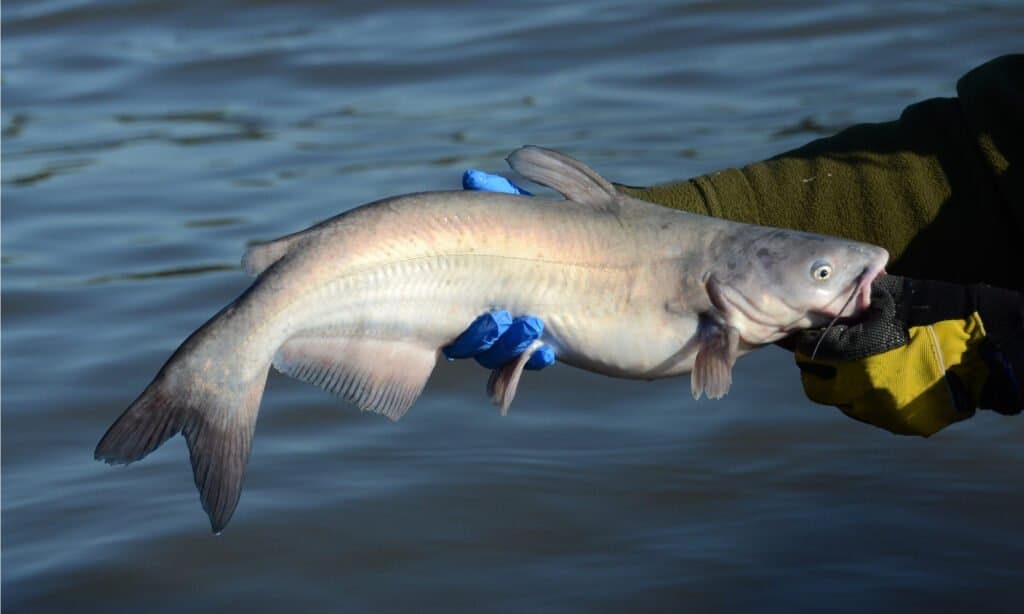
The blue
catfish
is the largest freshwater fish caught in South Carolina.
©M Huston/Shutterstock.com
| Scientific Name | Size | Location |
|---|---|---|
| Ictalurus furcatus | 2-3 feet on average, up to 5.5 feet. | Found in lakes and rivers throughout South Carolina, including the Savannah River and Lake Wateree. |
The blue catfish can get very large, and it’s the biggest freshwater fish caught in South Carolina. On average, it can measure between 2 and 3 feet long and weigh up to 40 pounds. The largest blue catfish in the state weighed 113 pounds!
These fish are known to live in many lakes and rivers throughout South Carolina, and many people claim Savannah River is a good place to catch large ones. Yet, South Carolina has many amazing creatures off its coasts that could count on this list including sharks, marlins, and even barracudas.
2. Mute Swan

Mute swans in south Carolina are mostly white with orange bills.
©Tone Trebar/Shutterstock.com
| Scientific Name | Size | Location |
|---|---|---|
| Cygnus olor | 6-7.9 feet wingspan | Usually found in large flocks in coastal regions in northern and eastern South Carolina. |
Although the trumpeter swan has a larger wingspan, it is incredibly rare. Therefore, it’s not fair to call it the biggest bird in South Carolina. Instead, the mute swan has the best claim to the title. This large swan is mostly white with an orange bill and some black coloration around the nostrils.
They have a total length of about 4-5 feet, but their wingspan of almost 8 feet is massive! They do not appear frequently, but they are usually found near the coast, especially in the north and eastern portions of the state.
3. Black Bear

Black bears are found in the western and eastern parts of South Carolina.
©BGSmith/Shutterstock.com
| Scientific Name | Size | Location |
|---|---|---|
| Ursus americanus | 5 to 6 feet in length | They are found in the western and eastern parts of the state, living in mountain forests as well as coastal plains. |
The black bear is one of the largest animals in South Carolina, and it’s certainly not one that people should take lightly. Black bears are often portrayed as skittish and goofy, but they can turn into killers in a flash. They can grow up to 6 feet in length and weigh over 300 pounds at their largest.
Interestingly, elk have started to be seen in South Carolina as they wander in from North Carolina. However, there is not a significant number of elk or a breeding population, so they’re still considered extirpated in the region.
4. American Alligator
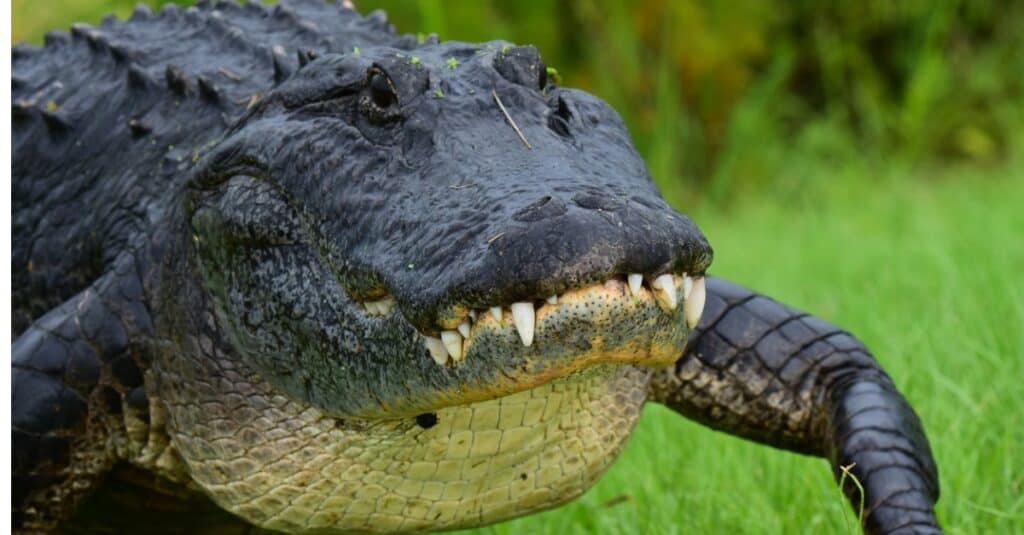
Alligators are very common in South Carolina.
©iStock.com/cturtletrax
| Scientific Name | Size | Location |
|---|---|---|
| Alligator mississippiensis | 8.5-15 feet long | Found in South Carolina’s coastal plains in freshwater swamps, rivers, and lakes. |
The American alligator is far more common in South Carolina than in North Carolina. It’s believed that 100,000 or more of these reptiles live in the state. They live in coastal plains that cover much of the state, but they do not travel to the northwestern portion.
Alligators can grow up to 15 feet long and can weigh over 1,000 pounds! You should not approach these reptiles because they can be very dangerous to humans.
5. Two-toed Amphiuma

The two-toed amphiuma is the largest
salamander
in South Carolina.
©Rosa Jay/Shutterstock.com
| Scientific Name | Size | Location |
|---|---|---|
| Amphiuma means | 1-3.8 feet in length | Mostly found in coastal plains in streams, swamps, and canals. |
The two-toed amphiuma is an aquatic salamander and the largest amphibian in the state. It can grow between 1 and 3.8 feet in length and is almost exclusively found in the coastal plains in South Carolina.
These creatures live in swamps, streams, and canals, often hiding under debris but not always. They may resemble eels at first glance due to their small limbs. They’re usually brown, nearly black, or dark grey.
6. Giant Swallowtail Butterfly
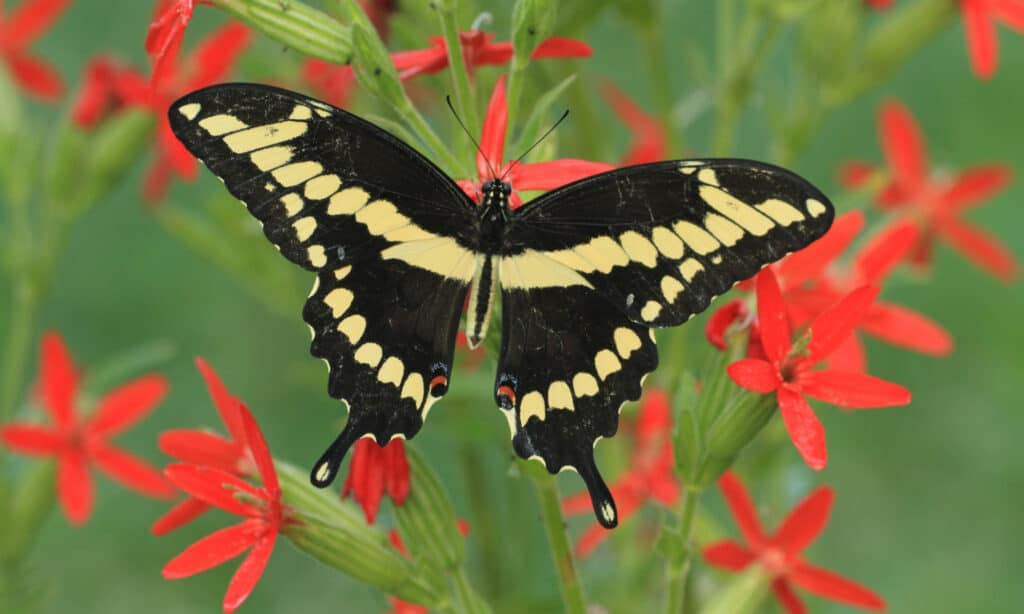
The giant swallowtail butterfly has a wingspan of up to 6 inches.
©Kevin Collison/Shutterstock.com
| Scientific Name | Size | Location |
|---|---|---|
| Papilio cresphontes | 4-6 inches in wingspan | Lives in coastal areas, fields, forests, swamps, suburbs, and more. |
The giant swallowtail butterfly is the largest in the U.S., and it often lives in the coastal regions of South Carolina. They have wingspans that can measure up to almost 6 inches, making them very large insects.
This butterfly is somewhat common in South Carolina, and it can be found in a variety of habitats along the coastal regions of the state. For example, they live in swamps, forests, and even suburbs. These beautiful butterflies are known for having black wings and yellow patterns across all four.
Swallowtail butterflies are one of the largest animals in South Carolina that you should feel comfortable and confident when approaching for pictures!
7. Carolina Wolf Spider
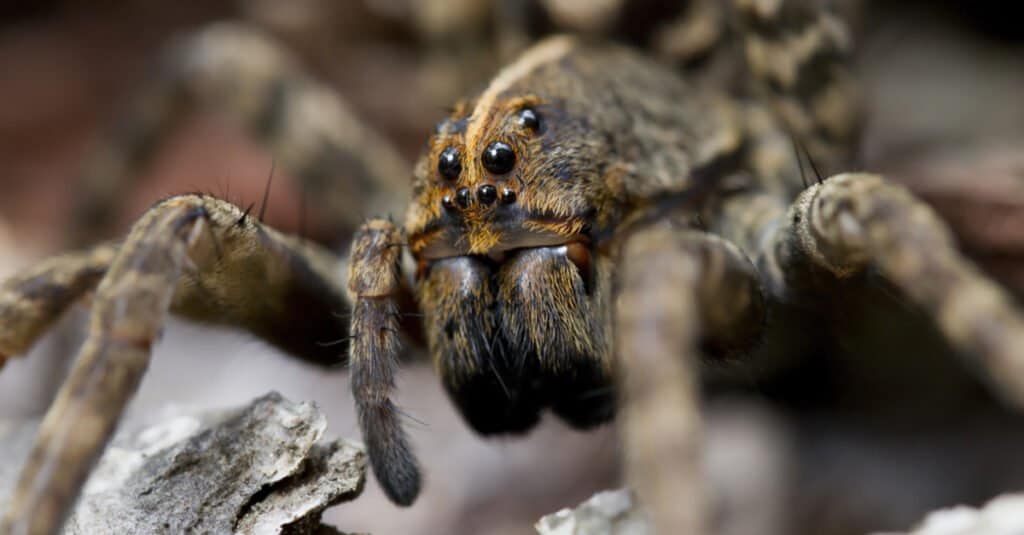
The Carolina wolf spider can grow up to 4 inches.
©Will E. Davis/Shutterstock.com
| Scientific Name | Size | Location |
|---|---|---|
| Hogna carolinensis | 2-4 inches in legspan | Often found in woods, areas with vegetation like farm fields, and near homes. |
The Carolina wolf spider has managed to frighten more than a few people in its day. This 4-inch-long spider often skitters around the rarely traveled parts of homes in pursuit of prey. Thus, these spiders live in basements, gardens around homes, fields, and more. You’ll basically find them in any part of South Carolina.
They may be large and hard to spot owing to their coloration, which helps them blend in a variety of settings. However, a wolf spider bite is not that serious if one does decide to bite you. Most often, they have to be coaxed to attack.
Having discovered the largest animals in South Carolina, you should feel more knowledgeable about the big creatures that live in this part of the country. Some of them are dangerous and must be avoided, like alligators and bears, but others are more interesting than anything else. Just remember to keep a respectful distance to remain safe.
Summary of The 7 Largest Animals In South Carolina
| Rank | Largest Animal | Location |
|---|---|---|
| 1 | Blue Catfish | Lakes & rivers, including the Savannah River & Lake Wateree. |
| 2 | Mute Swan | Coastal regions in northern and eastern South Carolina |
| 3 | Black Bear | Western and eastern parts of the state, in mountain forests and coastal plains |
| 4 | American Alligator | Coastal plains in freshwater swamps, rivers, and lakes |
| 5 | Two-toed Amphiuma | Coastal plains in streams, swamps, and canals |
| 6 | Giant Swallowtail Butterfly | Coastal areas, fields, forests, swamps, suburbs, and more |
| 7 | Carolina Wolf Spider | Woods, areas with vegetation like farm fields, and near homes |
The photo featured at the top of this post is © Tone Trebar/Shutterstock.com
Sources
- South Carolina Department of Natural Resources (1970) dnr.sc.gov/fish/freshrecs/records.html
- (1970) dnr.sc.gov/fish/species/bluecatfish.html#:~:text=Blue catfish are native to,lakes Wateree%2C Marion and Moultrie
- , Available here: https://www.dnr.sc.gov/wildlife/species/waterfowl/swans/muteswan.html
- , Available here: https://www.dnr.sc.gov/wildlife/species/bear.html
- Butterfly Identification (1970) butterflyidentification.org/butterflies-by-state-listing.php?reach=South Carolina
- Savannah River Ecology Laboratory (1970) srelherp.uga.edu/salamanders/ampmea.htm(opens in a new tab) srelherp.uga.edu/salamanders/ampmea.htm
Thank you for reading! Have some feedback for us? Contact the AZ Animals editorial team.






